OFFICIAL STATEMENT – Streamlining Our Core Operations
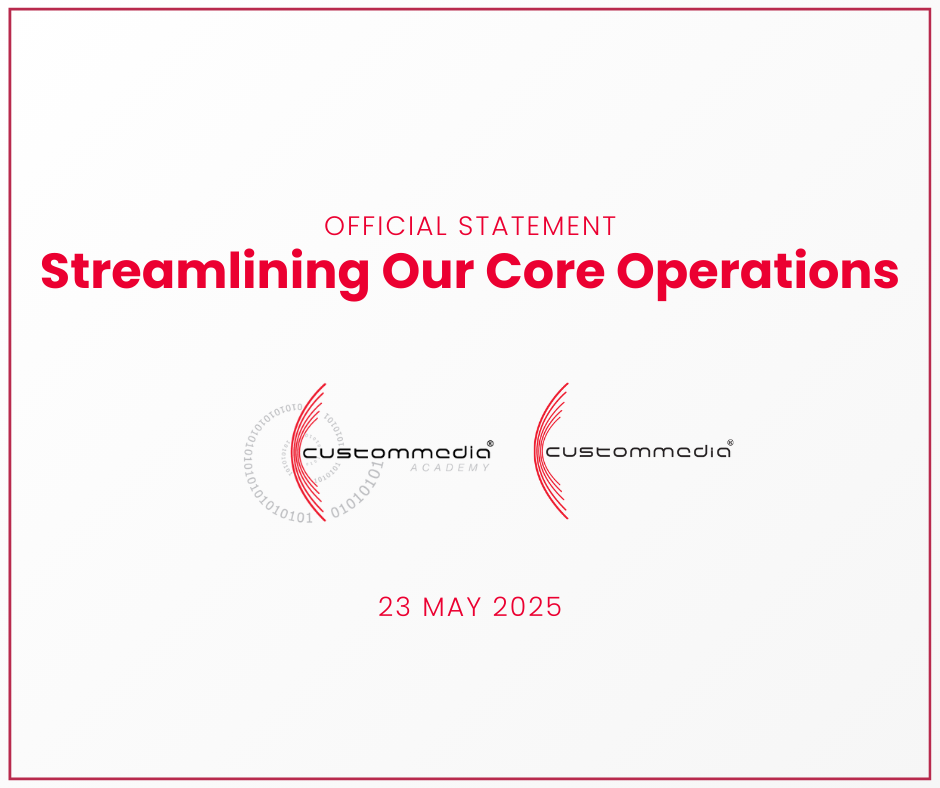
Puchong, 23 May — Custommedia announces a strategic realignment of our software engineering business operations; to streamline and further enhance our core focus on delivering exceptional professional training and software testing services. This necessary realignment is designed to reinforce organizational resilience, operational efficiency, and long-term growth. In the context of recent organizational changes, we want to assure all our valued clients that Custommedia and Custommedia Academy will remain operational, and we are committed and energized to serve your evolving business needs without interruption. Our commitment to excellence in software testing and professional training continues to be enhanced. This realignment allows us to channel our resources and expertise more effectively, ensuring our services continue to meet the highest standards of quality and innovation that our clients have come to expect from us. We will continue to leverage the latest advancements in AI technology, driving productivity and enhancing the quality and relevance of our solutions. We deeply appreciate the contributions of all our employees, past and present, who have significantly shaped our success. As we navigate this period of transformation, our priority remains clear: delivering outstanding value to our clients, supporting our team, and sustaining a resilient business capable of thriving in an ever-changing industry landscape. We are excited about the future and are dedicated to providing excellence and quality that will benefit our clients for years to come. We thank our clients for their continued trust and partnership as we embark on this focused chapter.
SEP White Label: Deliver Branded Events, Generate New Revenue

SEP White Label is tailored to give you full ownership over branding, features, and workflows. It’s designed for organizations ready to elevate their event management under their own banner — without compromising on performance, reliability, or scalability.
Functional vs. Non-Functional Testing Explained: Key Benefits for Business Success

Discover why functional and non-functional testing are critical for delivering reliable, secure, and high-performing software. Learn how Custommedia’s expertise ensures your applications excel under real-world conditions, safeguarding performance, security, and user satisfaction. Read on to explore the benefits of comprehensive software testing and how it drives business success in today’s digital era
Staff Bowling 2024

Beyond our dedication to innovative digital solutions, we’re a team that knows the value of play, and these shared experiences strengthen the bonds that drive our work every day.
From Registration to Certification: A Digital Approach to Corporate Training

Discover how SmartEvent Pro can help Malaysian SMEs streamline in-house corporate training, reduce costs, and improve employee engagement. Learn how digital solutions can automate training management tasks like registration, attendance tracking, and certificate issuance, allowing businesses to focus on upskilling their workforce efficiently.
Powering SOFTECAsia 2024: How Custommedia Leads Innovation Behind the Scenes
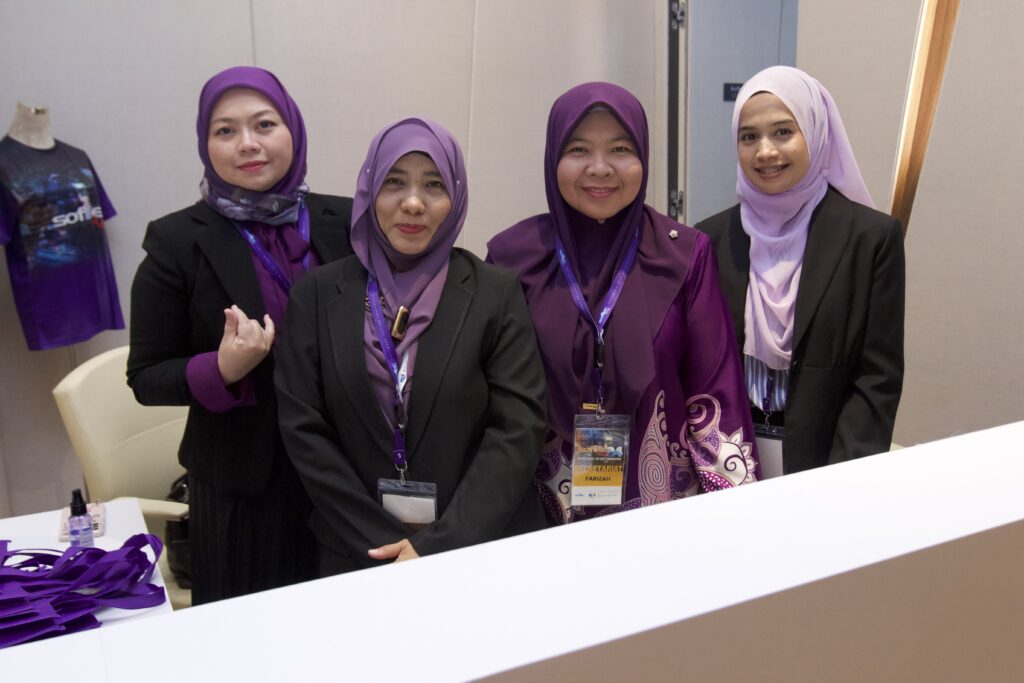
Powering SOFTECAsia 2024: How Custommedia Leads Innovation Behind the Scenes As the organizing partner of SOFTECAsia 2024, Custommedia plays an integral role in ensuring the success of this premier software testing conference. With the theme “Software Testing: The Next Generation,” SOFTECAsia 2024 focuses on emerging trends in Artificial Intelligence (AI), Machine Learning (ML), and Large Language Models (LLMs) that are transforming the field of Software Quality Assurance (SQA). In addition to being the organizing partner, Custommedia is the developer of the white-labeled SmartEventPro app used by the Malaysian Software Testing Board (MSTB), the main organizer of the event. Custommedia’s contributions to SOFTECAsia go beyond technology—they encompass event management, digital marketing, and strategic consultancy, ensuring a successful and innovative event experience for all attendees. SmartEvent Pro: Tailored to Meet SOFTECAsia’s Unique Needs Custommedia’s SmartEventPro app, used in a white-labeled form by MSTB, is a crucial part of SOFTECAsia 2024’s operational success. The app is not just a standard solution, but a customized platform tailored specifically to meet MSTB’s requirements for managing the conference and enhancing the attendee experience. Key customized features of SmartEventPro include: Online Ticketing & QR Check-ins: Attendees can seamlessly register and check in using QR codes, streamlining the process for a large and diverse audience, including corporate IT professionals, software testers, and government representatives. Multi-track Workshop Management: With SOFTECAsia offering workshops and talks across various tracks—from AI in testing to cybersecurity—SmartEventPro helps attendees navigate these choices efficiently, ensuring that they can participate in the sessions most relevant to their interests. Automated Certificates and Feedback: The app automatically generates e-certificates for attendees and allows for real-time feedback collection, ensuring that event organizers can continuously improve both during and after the event. This level of customization highlights how SmartEventPro is more than just a tool; it is a platform designed to address the specific needs of large-scale, complex conferences like SOFTECAsia. Digital Marketing Expertise: Boosting SOFTECAsia’s Reach As the digital marketing partner for SOFTECAsia 2024, Custommedia is responsible for a comprehensive range of activities, including web development, design, analytics, and SEO. These efforts are key to attracting the right audience, increasing engagement, and ensuring that SOFTECAsia maintains its position as a leading conference in the software testing industry. Website Development and Design: Custommedia’s team crafted a user-friendly and visually compelling website for SOFTECAsia, ensuring a smooth user experience from registration to post-event content access. The design aligns with the event’s forward-thinking theme, capturing the attention of industry professionals. SEO and Analytics: By leveraging advanced SEO strategies, Custommedia has significantly improved the online visibility of SOFTECAsia. This has helped to drive traffic from both domestic and international markets, ensuring that key stakeholders from across the software testing industry are aware of the event. Additionally, real-time analytics allow the event organizers to track engagement and refine their digital strategy as the event unfolds. Content Marketing: Through engaging blog posts, articles, and social media campaigns, Custommedia has been instrumental in building anticipation for SOFTECAsia 2024. By focusing on the conference’s key themes—such as AI in testing and cybersecurity—they have ensured that the right message reaches the right audience. Strategic Consultancy: Guiding Software Testing Trends Custommedia’s role as a strategic consultant at SOFTECAsia 2024 extends beyond its technology and marketing contributions. With decades of experience in Software Engineering and Software Quality Assurance, Custommedia offers invaluable insights into the latest trends and best practices in the industry. As a TMMi Level 5 accredited organization, Custommedia provides expert guidance on how emerging technologies, like test automation and cybersecurity testing, can be integrated into organizations’ SQA processes. Their strategic consultancy helps attendees stay ahead of the curve, ensuring that they leave the conference with actionable knowledge on how to enhance their testing capabilities. Conclusion From developing a customized event management platform with SmartEvent Pro to driving the event’s digital marketing strategy and providing cutting-edge consultancy on software testing trends, Custommedia’s role in SOFTECAsia 2024 is indispensable. Their multifaceted involvement ensures that the conference not only runs smoothly but also provides value to its diverse audience—whether through streamlined operations, increased digital visibility, or strategic insights into the future of software testing. As SOFTECAsia 2024 continues to push the boundaries of what is possible in SQA, Custommedia remains at the forefront, guiding the industry into the next generation of software testing innovation.
Strengthening Software Resilience: Learning from CrowdStrike’s Update Flaw

Strengthening Software Resilience: Learning from CrowdStrike’s Update Flaw Table of Contents A Billion-Dollar Lesson in Software Testing On July 19, 2024, CrowdStrike, a leading cybersecurity firm, released an update for its Falcon sensor for Windows. Intended to enhance the sensor’s functionality, this update inadvertently introduced a critical flaw, leading to a massive global outage. The bug triggered a logic error that caused affected machines to display the infamous Blue Screen of Death (BSOD), signalling severe system failures. As one of the largest cybersecurity firms in the U.S., serving more than half of the Fortune 500 companies, CrowdStrike’s faulty update had far-reaching and expensive ramifications. Approximately 8.5 million devices worldwide were impacted, disrupting various sectors including healthcare, financial services, and transportation. Hospitals experienced critical system failures, potentially endangering lives, financial institutions faced halted ATM transactions and online banking services, and airlines encountered extensive flight cancellations and delays. In Malaysia, Kuala Lumpur International Airport (KLIA) and KLIA2 were notably affected. The outage forced airline passengers to check in manually, with booking systems down and boarding passes issued by hand. This led to significant delays and confusion among travellers, particularly affecting AirAsia flights more than those of Malaysia Airlines and Firefly. The Necessity of Rigorous Testing Protocols The CrowdStrike incident starkly illustrates the critical need for rigorous testing protocols and a robust testing culture within organizations. The widespread impact and severity of the outage underscore how even a seemingly minor update can lead to catastrophic consequences if not thoroughly vetted. This serves as a stark reminder of the growing risk of single points of failure (SPOF), critical bottlenecks in system delivery that, if impacted, can cause outsized effects on the entire system. Sectors like healthcare and aviation, which require 24/7 availability, are particularly vulnerable due to their lack of robust redundancies. The root cause of the CrowdStrike incident was identified as a testing bug in their Content Validator, an error within their test automation tool. This flaw led to the release of a faulty update that caused widespread system failures. This incident underscores the importance of not only rigorous manual testing but also the need for robust automated testing tools and processes that can reliably detect and prevent such critical errors. The financial implications of the outage were substantial. Businesses relying on affected virtual machines (VMs) experienced significant downtime, leading to lost sales and productivity. For large enterprises, this downtime translated into millions of dollars in lost revenue per hour. Additionally, the costs associated with IT support—including diagnosing and resolving the issues—were considerable, encompassing both in-house IT staff and external support services. The total cost of the outage is still being calculated, with some estimates suggesting losses could exceed USD 1 billion. The incident also caused long-term reputational damage to CrowdStrike. Trust issues with clients emerged as businesses questioned the reliability of CrowdStrike’s services. This erosion of trust could lead to potential loss of business as affected companies might seek more reliable cybersecurity solutions. Despite CrowdStrike’s swift response and remediation efforts, the reputational damage could have lasting effects on their client relationships and market position. Overall, the CrowdStrike incident highlights the critical need for comprehensive and robust testing protocols to prevent such widespread disruptions and ensure the reliability and security of IT systems. The Role of Testing in Software Development The CrowdStrike incident underscores the critical importance of robust testing practices in software development. To ensure software functions correctly and reliably under all conditions, both functional and non-functional testing are essential. Functional and Non-Functional Testing: Definitions and Importance Functional testing focuses on verifying that the software performs its intended functions correctly. It involves testing the software against functional requirements and specifications to ensure that all features work as expected. This type of testing is critical for identifying and fixing bugs that could prevent the software from meeting its objectives and satisfying user needs. Key benefits of functional testing include: Compliance validation Early issue detection Enhanced user confidence Quality assurance Non-functional testing, on the other hand, assesses the performance, usability, reliability, and other non-functional aspects of the software. It ensures the software performs well under various conditions, such as heavy loads, stress, and security threats. This type of testing is crucial for: Ensuring a positive user experience Meeting performance standards Maintaining system reliability Importance of Rigorous Testing Protocols and Patch Management The CrowdStrike outage highlights the necessity of rigorous testing protocols and effective patch management. Testing protocols must be comprehensive, covering both functional and non-functional aspects to ensure updates do not introduce new issues. Automated testing tools can help continuously validate the software’s functionality and performance, reducing the likelihood of bugs slipping through the cracks. Effective patch management involves not only deploying patches promptly but also thoroughly testing them before release. This process helps identify and mitigate potential issues that could lead to system failures, as seen in the CrowdStrike incident. Regular audits and reviews of the testing and patch management processes can further enhance the robustness of software systems, ensuring they remain reliable and secure. Establishing a Robust Testing Culture Creating a robust testing culture is essential for ensuring the reliability and quality of software products. This involves a holistic approach where all stakeholders are engaged, continuous training is emphasized, and best practices are rigorously followed. Essential Steps 1 Involvement of All Stakeholders in the Testing Process A successful testing culture requires the involvement of all stakeholders, from developers and testers to project managers and end-users. This collaboration ensures that everyone understands the importance of testing and contributes to the quality assurance process. Effective communication and transparency are crucial in fostering this collaborative environment. Organizations should encourage feedback and actively involve stakeholders in testing activities to promote a sense of ownership and responsibility for quality. 2 Continuous Training and Certification for Testers Continuous education is vital for maintaining a high standard of testing. Certifications such as the Certified Tester – Foundation Level from ISTQB® (International Software Testing Qualifications Board) and the Certified Professional for Requirements Engineering from IREB (International Requirements
The Future of Malaysian Fintech: Powered by IBM ELM
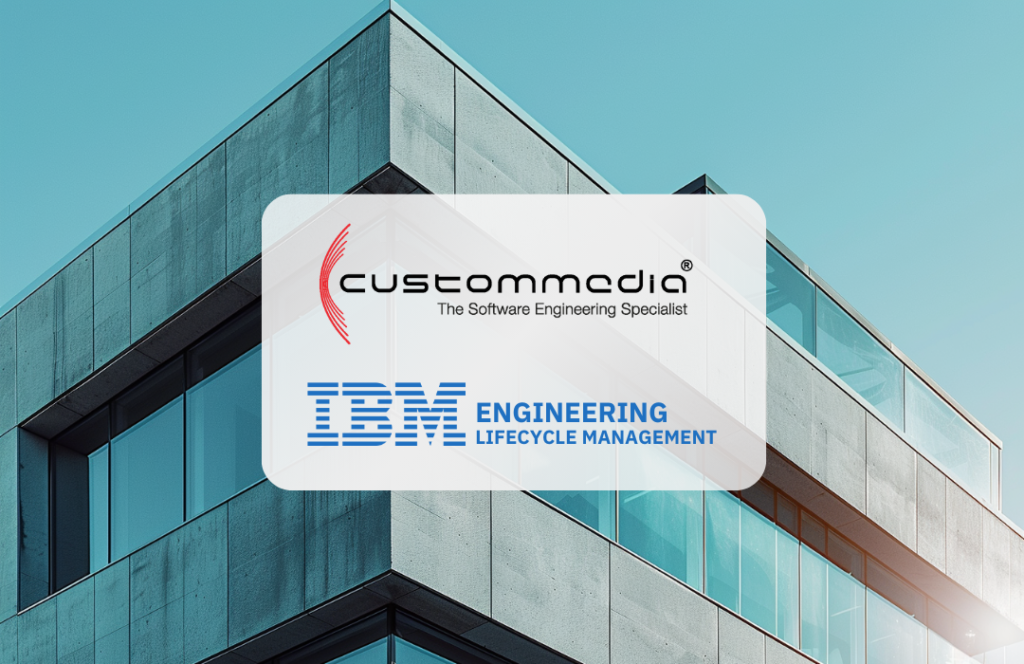
The Future of Malaysian Fintech: Powered by IBM ELM Malaysia’s fintech sector is experiencing an unprecedented wave of innovation and growth, driven by the advent of digital banking and the increasing demand for seamless financial services. Following the accelerating trend of digital transformation, three digital banks, namely GXBank, Boost Bank, and AEON Bank have emerged to date, offering streamlined and innovative banking solutions tailored to the needs of modern consumers and businesses. According to PwC’s Global FinTech Report, over 20% of financial services business is at risk due to the rise of fintech, emphasizing the urgency for traditional financial institutions to adapt and innovate. In this dynamic environment, fintech companies face numerous challenges, such as stringent regulatory requirements, heightened security risks, and the need for rapid time-to-market for new products. IBM Engineering Lifecycle Management (ELM) presents a robust solution to these challenges, offering comprehensive tools for managing complex software and systems engineering projects. This article explores how IBM ELM can address the specific needs of fintech companies in Malaysia, supporting them in navigating the complexities of the industry and driving sustainable growth. Table of Contents The Importance of Regulatory Compliance in Fintech Malaysia’s fintech landscape is heavily regulated to ensure financial stability, consumer protection, and compliance with international standards. Bank Negara Malaysia (BNM) plays a pivotal role in shaping the regulatory environment. Key regulations include the Financial Services Act (FSA) and the Islamic Financial Services Act (IFSA), which require digital banks to obtain licenses and adhere to stringent compliance measures. Additionally, BNM’s introduction of the Financial Technology Regulatory Sandbox in 2016 allows fintech companies to experiment with innovative solutions in a controlled environment, ensuring they meet regulatory requirements before full-scale implementation. (ISEAS Yusof Ishak Institute) IBM Engineering Lifecycle Management (ELM) provides comprehensive tools to help fintech companies navigate Malaysia’s complex regulatory landscape. One of the standout tools is IBM Engineering Requirements Management DOORS Next, which ensures that all regulatory requirements are captured, managed, and traced throughout the development lifecycle. This tool allows fintech companies to maintain a single source of truth for all regulatory requirements, ensuring that they are met consistently and efficiently. Improved Traceability, Auditability, and Streamlined Regulatory Processes with IBM DOORS Next Traceability IBM DOORS Next provides end-to-end traceability of regulatory requirements, enabling fintech companies to track each requirement from inception through implementation and testing. This feature is crucial for demonstrating compliance to regulators like BNM, as it allows for clear documentation of how each regulatory requirement is addressed. Auditability The tool enhances auditability by maintaining a detailed history of changes to requirements and their implementation. This makes it easier for fintech companies to undergo audits and inspections, providing regulators with a transparent view of compliance efforts. Streamlined Regulatory Processes By automating the management of regulatory requirements, IBM ELM reduces the administrative burden on fintech companies. This allows them to focus more on innovation and less on compliance paperwork. Additionally, the integration of requirements management with other lifecycle management tools ensures that compliance is built into every stage of product development, reducing the risk of non-compliance and costly rework. IBM DOORS Next provides end-to-end traceability of regulatory requirements, enabling fintech companies to track each requirement from inception through implementation and testing. This feature is crucial for demonstrating compliance to regulators like BNM, as it allows for clear documentation of how each regulatory requirement is addressed. The tool enhances auditability by maintaining a detailed history of changes to requirements and their implementation. This makes it easier for fintech companies to undergo audits and inspections, providing regulators with a transparent view of compliance efforts. By automating the management of regulatory requirements, IBM ELM reduces the administrative burden on fintech companies. This allows them to focus more on innovation and less on compliance paperwork. Additionally, the integration of requirements management with other lifecycle management tools ensures that compliance is built into every stage of product development, reducing the risk of non-compliance and costly rework. Enhancing Security and Risk Management In 2024, fintech companies, particularly those involved in digital banking, face a myriad of sophisticated cyber threats. Ransomware continues to be a significant concern, with recent widespread attacks in Latin America illustrating the potential for crippling service disruptions and reputational damage. Ransomware attacks often involve encrypting critical data and demanding a ransom to restore access, sometimes coupled with threats to leak sensitive information if the ransom is not paid. The shift to remote work and increased reliance on cloud services have also expanded the attack surface for cybercriminals. Misconfigured cloud infrastructures and inadequate endpoint security measures can leave financial institutions vulnerable to breaches. Moreover, supply chain attacks, where cybercriminals target third-party vendors to gain access to a bank’s network, are becoming more prevalent. (EPAM) IBM ELM’s Integrated Approach to Security Requirements and Risk Management IBM Engineering Lifecycle Management (ELM) provides an integrated approach to managing security requirements and mitigating risks across the software development lifecycle. One of the key components, IBM Engineering Requirements Management DOORS Next, enables fintech companies to systematically capture, track, and manage security requirements. This ensures that security considerations are integrated into every phase of development, from initial design through to deployment and maintenance. By using IBM ELM, fintech companies can implement real-time visibility into their security posture, allowing them to quickly identify and address vulnerabilities. The platform supports comprehensive risk management practices, helping companies proactively assess potential threats and implement mitigation strategies before issues arise. This proactive approach is crucial for managing the dynamic and evolving cyber threat landscape. Accelerating Time-to-Market The fintech industry is characterized by rapid technological advancements and intense competition. Companies are under constant pressure to innovate quickly and bring new products to market to meet the evolving demands of consumers and businesses. The adoption of technologies such as AI, blockchain, and open banking is transforming financial services, driving the need for fintech companies to stay ahead of the curve. (McKinsey & Company) Rapid innovation is not just a strategic advantage; it’s a necessity. The shift towards digital and mobile-first financial solutions means that fintech
Company Team Building – Lembah Temir Resort, Pahang
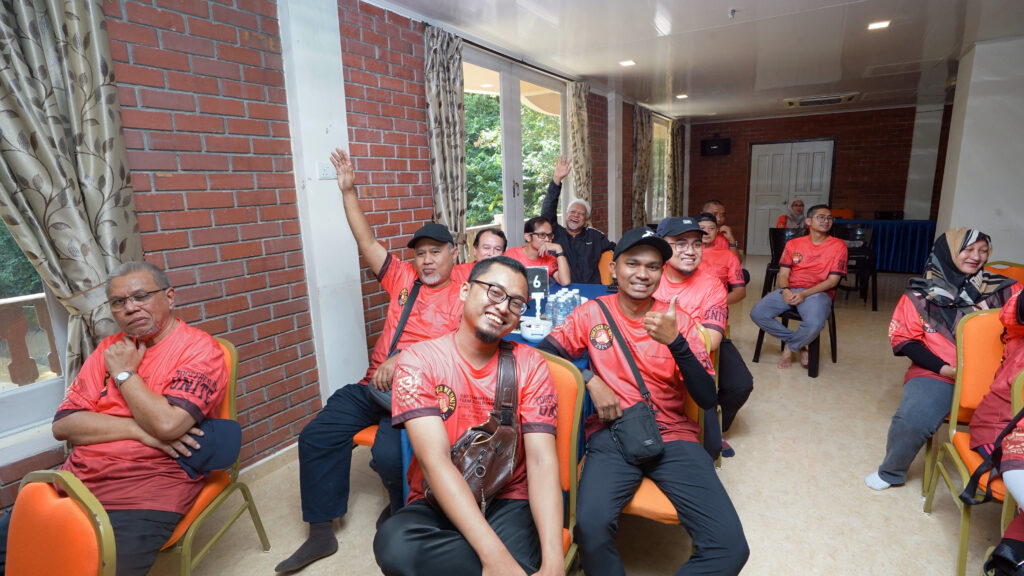
Together We Unite! The Custommedia management team together with all our staff members had an engaging and revitalizing team building activity on the 19th and 20th of May 2024. Held deep in the midst of lush durian trees and pristine waterfalls of Lembah Temir, we strengthened the existing bond within the company to move forward together and united, with energy and confidence.
A Step Ahead in Quality Assurance: Our Journey to TMMi Level 5
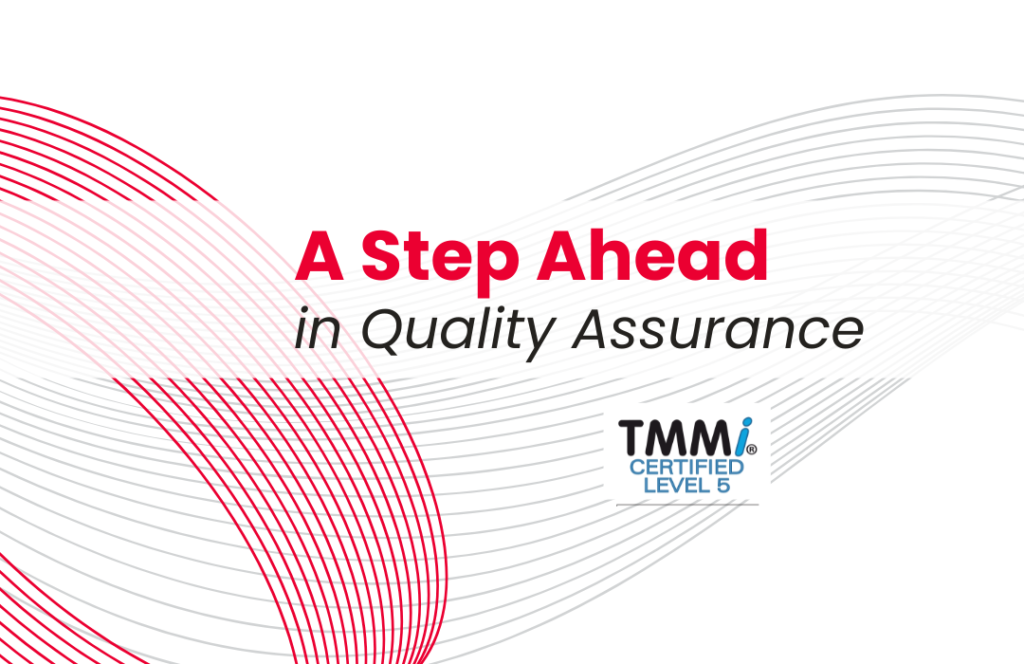
Our sustained achievement in holding the TMMi Level 5 certification since 2016 not only marks a milestone but also aligns with our deep-seated commitment to the highest standards in software testing. This certification is not merely an accolade—it represents our continuous drive to refine our testing processes and enhance the quality of services we offer to our clients. Understanding TMMi The Test Maturity Model Integration (TMMi) framework is pivotal for organizations striving to improve their test processes. Developed by the TMMi Foundation, it is modeled after the Capability Maturity Model Integration (CMMI), which has been a cornerstone in software engineering process improvement. TMMi provides a structured pathway for organizations to progress through five maturity levels, from the initial phase of managed processes to an optimized state of continuous improvement. Achieving Level 5, the highest maturity level, signifies that an organization has successfully integrated continuous process and technological advancements into their operations, enabling them to adapt swiftly to new challenges and changes in the technology landscape. The Criticality of Software Testing Models Software testing models like TMMi are crucial because they establish a benchmark for best practices in testing, which is critical for ensuring the reliability, security, and performance of software applications. In today’s digital age, where software pervades every aspect of business and personal life, the importance of robust software testing cannot be overstated. Testing models provide a systematic approach to detecting defects early in the development cycle, reducing the cost of failure, and ensuring that software meets both functional and non-functional requirements. This is especially significant in industries where software failures can have severe implications, such as in finance, healthcare, and aviation. A Step Ahead Being a TMMi Level 5 certified organization places Custommedia among the elite in software testing, offering significant benefits to our clients: Our Expertise For over eight years, Custommedia has consistently met and often exceeded the rigorous standards required to maintain TMMi Level 5 certification. Our team of ISTQB-certified engineers is skilled in a wide range of testing types, including functional, performance, security, and usability testing. This diverse expertise positions us uniquely to address the evolving demands of the technology landscape. Our commitment to investing in our people and technologies ensures that we stay at the forefront of industry advancements, ready to meet and exceed the expectations of our clients.
